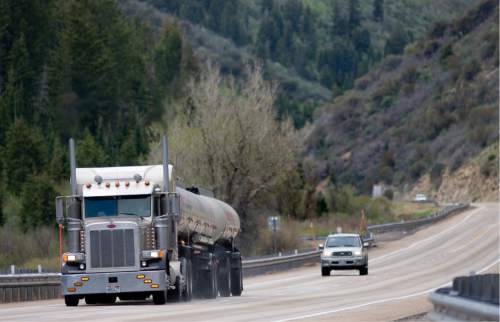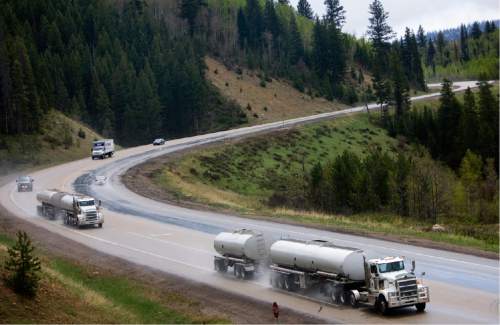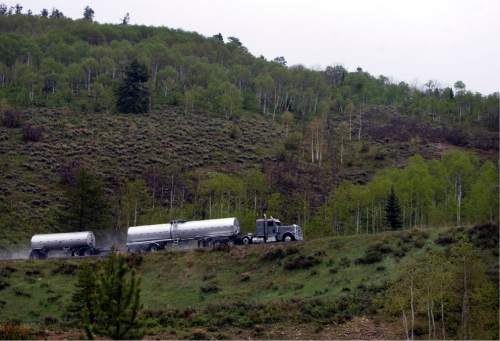This is an archived article that was published on sltrib.com in 2016, and information in the article may be outdated. It is provided only for personal research purposes and may not be reprinted.
Despite the current downturn in oil and gas development, the Bureau of Land Management this week announced a massive drilling proposal spanning the heart of the Uinta Basin, covering three unincorporated towns, several rivers and two reservoirs and requiring hundreds of miles of new roads and pipelines.
Crescent Point Energy, a Canadian firm that has been investing heavily in the basin since 2012, is seeking approvals to drill up to 3,925 wells on a 35-mile-long swath running east from Myton to beyond the Green River. On Thursday, the BLM posted a scoping notice on the Federal Register, opening a public comment period through May 9 that will guide an environmental impact statement (EIS).
"We are starting a lengthy process because we want to make sure we get lots of public input. Unlike other oil and gas projects, we are closer to small communities," said BLM project manager Stephanie Howard. The towns of Randlett and Leota are inside the project area, while Myton, Roosevelt, Ballard, Fort Duchesne, Gusher and Ouray are within a few miles.
Crescent Point, based in Calgary, produces oil and gas around North America and its Utah operations are overseen by its U.S. subsidiary. A voicemail left with the subsidiary's Denver headquarters was not returned Friday.
And thousands more wells are proposed nearby. In the next few months, the BLM expects to release a final EIS on the 120,000-acre Monument Butte project, where Newfield Exploration Co. wants to drill up to 5,700 wells at a rate of 250 a year. That proposal abuts the southwestern end of Crescent Point's project area,
Crescent Point's 115,110-acre project area is a complicated patchwork of federal, tribal, state and private lands. According to Howard, the BLM and two other federal agencies — Bureau of Reclamation and the Utah Reclamation Mitigation and Conservation Commission — own 37 percent of the surface acreage. Private holders own 39 percent; the Ute Indian Tribe 19 percent; and the School and Institutional Trust Lands Administration 4 percent.
The project envisions the construction of 863 miles of roads; 693 miles of pipelines co-located with roads; 170 miles of cross-country pipelines; 400 miles of trunk pipelines; five salt-water disposal wells; five facilities to treat "produced" waste water; 20 central tank batteries; four gas-processing plants; eight oil-storage areas; and four equipment-storage areas.
While none of the project area is roadless or proposed for wilderness, it virtually envelops the Ouray National Wildlife Refuge, a vital sanctuary for migratory birds on the Green River. And some of the land overlaps sage grouse habitat that is subject to special drilling restrictions, under the federal land-use plans adopted last September to keep the bird off the endangered species list.
Much of the area has already been developed, with leases dating back to the 1940s and 400 wells in place, according to Howard.
The Uinta, Duchesne and Green rivers and Dry Gulch Creek flow though the project area, which covers Pelican Lake and Brough Reservoir, considered blue-ribbon fisheries.
The EIS will consider the broad impacts of the project.
"We will quantify emissions from transportation associated with the project. Right now, it looks like trucks," Howard said.
However, it is likely a pipeline would be built at some point during the 30-year life of the project to move oil from the basin over the Book Cliffs to rail load-outs at Wellington. Three different groups have filed right-of-way applications with the BLM for such a project, including a joint proposal from Duchesne and Carbon counties.
Crescent Point is Utah's fourth-largest oil producer. Despite persistent low crude prices that have quieted Utah's drilling boom, the firm continues drilling its Utah leases, which hold reserves estimated to be 5.2 billion barrels, according to its most recent financial disclosures. It expects to spend nearly $35 million drilling seven wells this year and to produce nearly 10,000 barrels of oil a day from 765 active wells in the basin, plus associated liquid fuels and shale gas.
According to the Utah Division of Oil, Gas and Mining (DOGM), however, just two rigs are currently drilling new wells in Utah and the industry has applied for only 58 drilling permits this year as of April 8.
State regulators have praised Crescent Point's environmental record in the past. DOGM honored Crescent Point with two Earth Day awards last year, one for the delicate way it conducted its 3D seismic surveys on the western part of its project area. That project avoided thumping ground where rare penstemon flowers grew. The company's second award involved archaeological and paleontological discoveries on private land along a road it was building to a well. Although no mitigation was required, Crescent Point developed a plan to document and protect each site, which featured ancient rock art and the remains of an extinct carnivore.
Twitter: @brianmaffly
Brian Maffly covers public lands for The Salt Lake Tribune. Maffly can be reached at bmaffly@sltrib.com or 801-257-8713.









